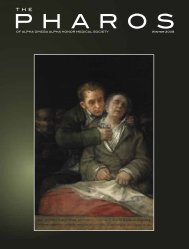4 - Alpha Omega Alpha
4 - Alpha Omega Alpha
4 - Alpha Omega Alpha
You also want an ePaper? Increase the reach of your titles
YUMPU automatically turns print PDFs into web optimized ePapers that Google loves.
Letters to the editor<br />
Locked-in syndrome<br />
I enjoyed the review of The Diving<br />
Bell and the Butterfly by my friend and<br />
classmate Peter Dans in the Autumn<br />
2008 issue of The Pharos. I would<br />
agree with his characterization of the<br />
film as outstanding and, as a neurologist,<br />
I found the depiction of a patient<br />
with the locked-in syndrome quite<br />
accurate. The protagonist showed<br />
remarkable inner strength and intelligence<br />
despite his desperate condition,<br />
being unable to move or speak and<br />
only able to communicate with eye<br />
blinks. Bauby, the patient, had a contract<br />
to write a feminine counterpart<br />
of The Count of Monte Cristo, presenting<br />
a powerfully ironic situation,<br />
as its author, Alexandre Dumas, père,<br />
penned the first literary depiction of a<br />
person with the locked-in syndrome in<br />
this novel. Whether or not the screen<br />
writer knew this is not clear.<br />
The description of “the paralytic,”<br />
who was in this state for six years, is as<br />
follows:<br />
M. Noirtier, although almost as immovable<br />
and helpless as a corpse,<br />
looked at the new-comers with a<br />
quick and intelligent expression . . .<br />
Sight and hearing were the only<br />
senses remaining, and appeared<br />
left, like two solitary sparks, to<br />
animate the miserable body which<br />
seemed fit for nothing but the<br />
grave. The speaking eye sufficed<br />
for all. He commanded with it; it<br />
was the medium through which his<br />
thanks were conveyed. 1<br />
As in the movie, there were<br />
several people who learned to<br />
communicate with Noirtier by<br />
attempting to interpret his<br />
eye blinks. His granddaughter<br />
Valentine,<br />
however, worked<br />
out a system much like that used by the<br />
speech pathologist in the film. She first<br />
recited the letters of the alphabet until<br />
Noirtier indicated that the first letter of<br />
the word he wanted was reached. The<br />
second letter of the word was than determined<br />
the same way. Valentine then<br />
held up a dictionary and ran her fingers<br />
down the columns until her grandfather<br />
signaled that she was at the word<br />
he wanted.<br />
Although rare, the locked-in syndrome<br />
occurs often enough that it<br />
needs to be considered in the differential<br />
diagnosis of any patient who has<br />
no voluntary movements but seems to<br />
have some level of wakefulness. These<br />
patients are individuals with whom reliable<br />
communication can be achieved,<br />
unlike patients with coma, the chronic<br />
vegetative state, or conditions associated<br />
with minimal consciousness.<br />
The same careful assessment needs<br />
to be applied to children, as the syndrome<br />
has been reported in pediatric<br />
patients. 2 Patients with amyotrophic<br />
lateral sclerosis and some other neuromuscular<br />
conditions can eventually<br />
become locked-in, but this does not<br />
occur calamitously as in the case of a<br />
stroke or traumatic brain injury.<br />
References<br />
1. Dumas A. The Count of Monte Cristo.<br />
Chapter 39, M. Noirtier de Villefort.<br />
2. Golden GS, Leeds N, Kremenitzer<br />
MW, Russman BS. The “locked-in” syndrome<br />
in children. J Pediatrics 1976; 89:<br />
596–98.<br />
Gerald S. Golden, MD<br />
(AΩA, Columbia University College of<br />
Physicians & Surgeons, 1961)<br />
Anatomy—with or without a<br />
cadaver<br />
It was a pleasure to read the<br />
Autumn 2008 issue of The Pharos.<br />
I read with great interest the article,<br />
“Bring out your dead?” by W. Roy<br />
Smythe (pp. 10–15). In Nepal, dissection<br />
is a necessary component of the<br />
gross anatomy curriculum for medical<br />
students. Students dissect certain<br />
regions of the body and are shown<br />
prosected specimens of other regions.<br />
During the practical examinations, students<br />
do not have to dissect the human<br />
body but are shown prosected specimens<br />
and identification of individual<br />
structures followed by a viva voce with<br />
the examiner.<br />
In Nepal, the basic science subjects<br />
of anatomy, physiology, biochemistry,<br />
pathology, microbiology, and pharmacology<br />
are taught in an integrated<br />
organ system-based manner during<br />
the first two years of the undergraduate<br />
medical (MBBS) course. A survey<br />
was carried out in a medical school in<br />
western Nepal to study the emotional<br />
impact of cadaver dissection using the<br />
appraisal of life events (ALE) scale. 1<br />
The loss, challenge, and threat scores<br />
were compared initially on first exposure<br />
to dissection and at the time of<br />
the study. The loss and threat scores<br />
declined over the course of study. The<br />
loss and threat scores were lower than<br />
that reported previously. The challenge<br />
scores were higher. Majority of students<br />
considered anatomy dissection as<br />
a significant positive life experience.<br />
The December 2004 issue of the<br />
magazine The Clinical Teacher had<br />
an interesting article about how a new<br />
medical school in the United Kingdom<br />
teaches anatomy without cadavers. 2<br />
The department decided that they<br />
would rely on living anatomy and<br />
medical imaging. Peer examination, life<br />
models, body projection, body painting,<br />
digital surface anatomy atlases,<br />
computer models, and simulations are<br />
among the various methods used. A<br />
major disadvantage of dissection ac-<br />
50 The Pharos/Spring 2009














